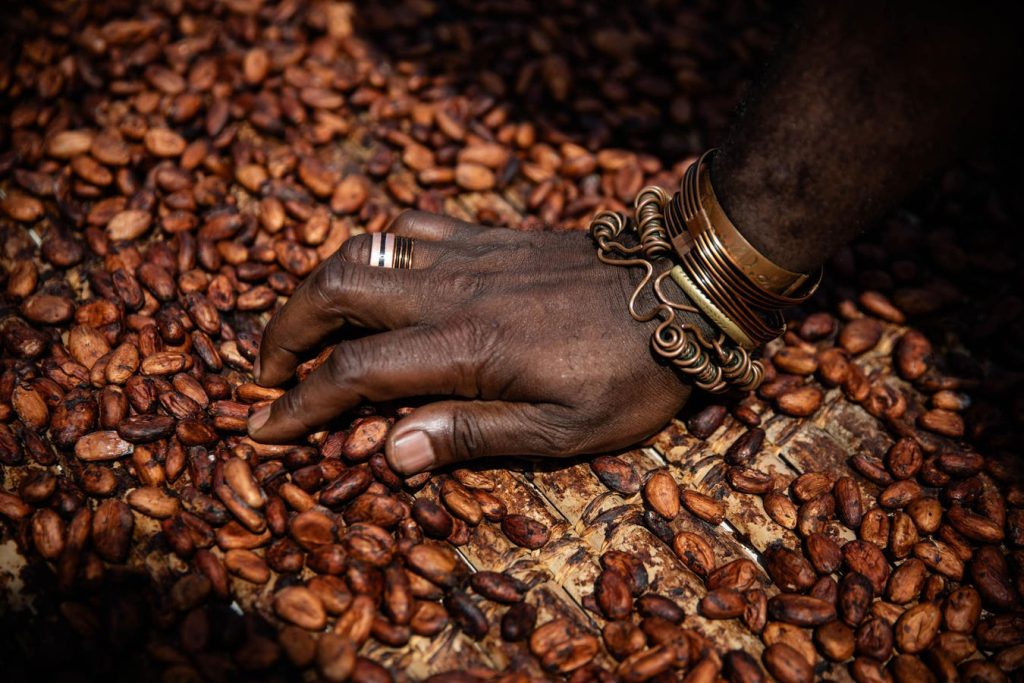Environmental disruptions due to climate change are causing cacao trees to die, raising chocolate prices and underscoring the need for sustainable cocoa efforts in the U.S. and Europe.
Higher temperature patterns alone or combined with more humidity from rain are changing environmental characteristics in a 40-degree wide area around the earth where cocoa beans typically grow. The trees can be found in an area 20 degrees above and below the equator.
Within this tropical band, the world’s cocoa farmers mostly live in Brazil, Cameroon, Côte d’Ivoire, the Dominican Republic, Ecuador, Ghana, Indonesia, Nigeria and Peru. Together they produce about 90% of the globe’s cocoa beans, numbering about five million tonnes annually.
Cacao trees are sensitive to environmental changes and don’t produce beans well in diverse conditions and extreme weather, which is bringing adversity to farmers and the chocolate business. It takes new cacao trees at least three years to produce beans.
A changing climate in Cote d’Ivoire and Ghana (where over half of all cocoa beans grow) is enabling mealybug populations to thrive in hotter and wetter weather. Most people don’t think of insects as a factor in climate change. Yet, these insects are burgeoning in greater humidity and bringing a deadly swollen shoot virus that is killing cacao trees. The National Oceanic and Atmospheric Administration estimates the virus has caused 200 million trees to die, forcing cocoa bean prices to rise.
NOAA also attributes the same climate change issues (greater heatwaves and stronger rainfall) to causing the spread of a fungus called black pod disease that also results in more dead cacao trees.
In March, the United Nations Trade and Development office released a statement with startling figures about how recent cocoa bean prices have been skyrocketing. UNCTAD highlighted the fact that for the first time cocoa futures price hit a record $10,000 per metric tonne.
“Extreme weather and changing climate patterns have upended crop harvests, which are expected to fall short for the third year in a row, tightening global supplies and raising prices,” UNCTAD stated, citing its commodities price figures. “The cost of cocoa, the key ingredient for making the beloved sweets, shot up by 136% between July 2022 and February 2024.”
To counter the negative impacts of climate change coupled with deforestation in the cocoa bean industry, U.S. and European stakeholders (where leading chocolate producers make and sell goods from cocoa beans) are turning sustainable cocoa solutions.
For instance, the U.S. Agency for International Development embarked on a project in mid-2023 with the government of Indonesia and private industry to train 6,500 cocoa bean and coffee farmers in sustainable agroforestry techniques in East Nusa Tenggara, North Sumatra and South Sulawesi. Farmers in those areas have been coping with fewer bean-producing trees due to climate change, inferior soil quality and poor tree health. The project’s goal is to help farmers diversify crops, grow more trees and better handle changing climate patterns.
Among the leading cocoa bean buyers, the United States is a major player in the chocolate business. Exporting chocolate products is an important part of the U.S. economy. In 2023, the United States imported $3.9 billion and exported $1.9 billion worth of chocolate and cocoa products, U.S. Department of Agriculture figures note. The nation’s with the biggest appetites for exported American chocolate goods last year were Canada (46%), Mexico (15%) and Vietnam (3%).
Also purchasing large quantities of cocoa beans to produce chocolate sweets, Europe is involved in efforts to encourage more sustainable cocoa.
Processing 10% of the world’s cocoa, Germany has launched its “German Initiative on Sustainable Cocoa”. The mission is to improve the living conditions of bean farmers and only buy 100% sustainable cocoa. Germany’s Federal Ministry of Food and Agriculture says that as of 2023, it had succeeded in raising to 92.2% the level of sustainably produced cocoa sweets sold there by initiative members.
Next door in Switzerland is an association called the Swiss Platform for Sustainable Cocoa. Its members include the State Secretariat for Economic Affairs, Swiss chocolate makers, bean traders and research groups. The Swiss group is pushing for more imports of sustainable cocoa. In July, it touted reaching a goal last year to ensure that by 2025, 80% of all Swiss imports will be from sustainable cocoa.
Creating a greater awareness about sustainable cocoa practices has the ability to transcend a marketplace outcome beyond being centered mostly on the availability of chocolate goods for consumers. Sustainable cocoa projects also can make significant positive differences in the livelihoods of farmers and their families.
Read the full article here






